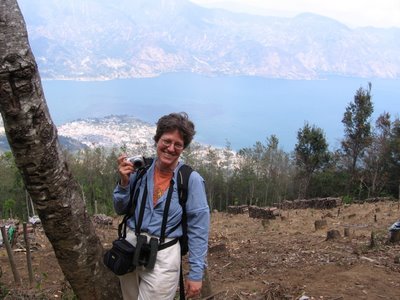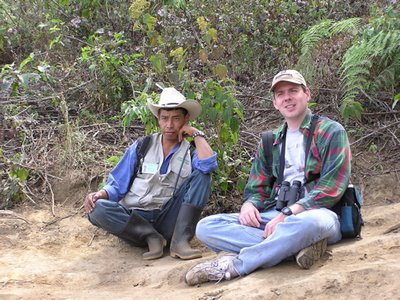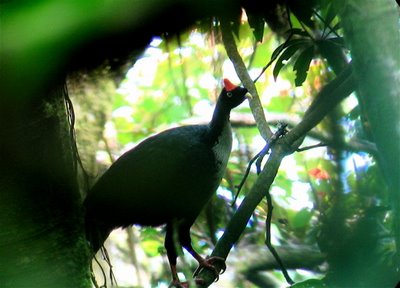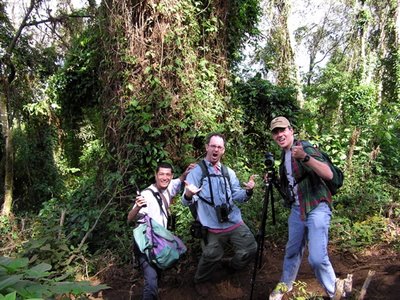Ecotourism's Cutting Edge

Well, I'm on NPR's All Things Considered tonight, at about 6:15 eastern, the fourth story in the first hour of the show. I'm talking about the trip up Volcan San Pedro in Guatemala to see the horned guan. An audio file of the commentary is available on NPR's web site, along with a picture or two from the trip.
Ecotourism's Cutting Edge
Only one hundred feet to go. My companions are crouching up the trail, gesturing, smiling, urging me upward. I'm at the absolute limit of my endurance. We have been climbing this volcano in Guatemala for almost five hours. It's early afternoon. Every muscle in our bodies is shrieking with pain. And two armed Guatemalan guards, who went ahead of our band of birders, have found the object of our quest: the horned guan.
My husband Bill is lugging a spotting scope and tripod. I have a 20-pound pack, with field guide, optical equipment, camera, sketchbook. My breath comes in ragged sobs, and I drop to all fours, struggling upward, praying that the great bird stays just a few more moments. The horned guan is found only on a few forested volcano fastnesses in Guatemala and Mexico. It's in the curassow family, something like a turkey, something like a peacock; nothing like either. It is the size of a Canada goose-shiny black and white, with a blank white eye and a peculiar red horn sticking up atop its head. It looks like a feathered dinosaur, and biologically speaking it almost is. It is the rarest of the rare.
There are a dozen people in our group, most of them lifelong birders. We have climbed this volcano, wending our way upward through coffee and corn patches, to reach the tonsure of remnant forest around the volcano's peak where the horned guan still lives.
 Juliano, our Mayan guide, with Marco Centeno, Guatemalan ornithologist and terrific guy
Juliano, our Mayan guide, with Marco Centeno, Guatemalan ornithologist and terrific guyMarco Centeno, the Guatemalan ornithologist who's brought us here, confesses later that, despite our effort, we had only about a five percent chance of seeing the guan. I'm glad I didn't know that at dawn, when we started climbing. I crawl and fall and gasp and finally I am there and the guan is before me, staring at me with that white eye, expressionless, surely wondering what is wrong with me.

Soon it spreads its great blue-black wings, crouches, leaps, and is gone in the thick canopy, only a leaf fluttering down to show where it had been. But I have seen it, and the agonizing climb and even worse descent seem a small price to pay.
I flop down beside Juliano, one of our Mayan guides, laughing weakly, giddy with exhilaration. We talk about the bird that he calls Pavo de Cacho. “Pavo de Cacho es muy bien,” he comments. At first I think he's saying it's a neat bird, until I get his meaning. “Para comer?” I ask, and he nods. “Muy bien.”
So here I sit, drenched in high-powered optics and my own sweat, out $300 for the privilege of climbing this immense volcano on the small chance I might glimpse the horned guan before it goes extinct. And Juliano has gnawed on their bones. Here, high above Lake Atitlan, we're on the cutting edge of ecotourism. I hope that this little multinational expedition of Americans, Canadians, Brits and Guatemalans proves that a horned guan is worth more alive than dead. Back at the foot of the mountain, we all pool our money to tip our guides, hoping to buy a little more time for the guan. I look up at the coffee plantations and patches of corn that checkerboard the volcano's vast flanks, remember the guan's wild stare, and hope hard that our children will someday look into those eyes, too.
 Hugo Enriquez, Bill Thompson III, and Marco Centeno, celebrating their sighting atop Volcan San Pedro.
Hugo Enriquez, Bill Thompson III, and Marco Centeno, celebrating their sighting atop Volcan San Pedro.






<< Home